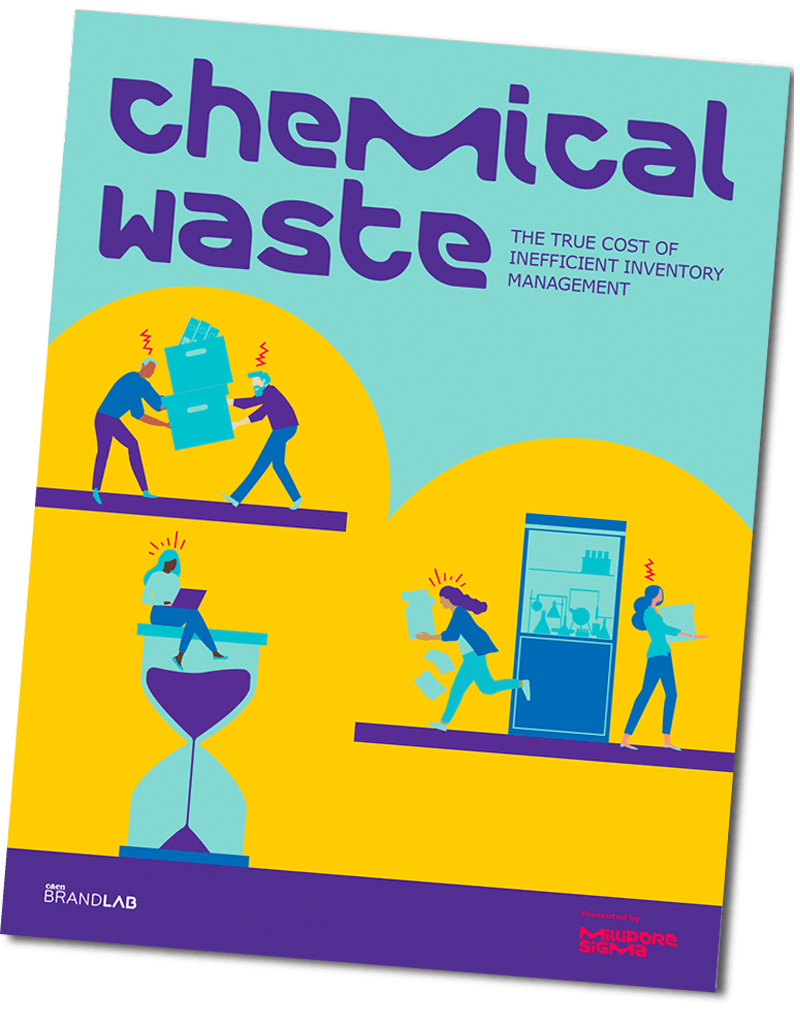wastenot
C&EN BrandLab
Scientific progress takes more than brain power—it also requires tremendous amounts of energy, raw materials, and other resources that can collectively exact a heavy environmental toll. “Labs use 10 times as much energy as a typical commercial office space and use three to five times as much water,” says James Connelly, CEO of My Green Lab, a nonprofit focused on sustainable research. “They also produce a significant amount of plastic and other hazardous waste.”
Much of this resource consumption is unavoidable, but a growing number of scientists around the world are demonstrating measures that can meaningfully reduce laboratory waste and help make research greener. These include approaches such as using power-hungry lab equipment mindfully and employing digital tools like LANEXO™ from MilliporeSigma, which enables more effective inventory management and minimizes chemical waste by providing an accurate, real-time representation of current reagent stocks.
Much of Jeffrey Whitford’s work as head of sustainability, social business innovation, and branding at MilliporeSigma is focused on helping scientists reduce their environmental impact without hindering their research, and Whitford notes that the green labs movement has been growing for the better part of a decade. “But in the past year and a half, it has just skyrocketed,” he says. “Hardly a day goes by that there isn’t a new request for some type of information about what we’re doing.” Multiple certification programs now offer guidance for improving lab sustainability, including the University College of London–based Laboratory Efficiency Assessment Framework (LEAF) and My Green Lab, which has established relationships with nearly 800 labs in 14 countries.
Although many of these are university labs, Connelly says they’re actively engaged with large pharmaceutical companies. His organization is lobbying governments to take proactive steps to make the research enterprise more sustainable by embracing green labs certification programs. “We're actually advocating to the US Department of Health and Human Services to try to incorporate it into grantmaking,” Connelly says. That way, he adds, people would “get better funding or are more likely to get funding if they implement green lab principles.”
Chipping away at waste
One of the biggest obstacles to establishing sustainable practices in the lab is the misperception that change, by its very nature, is cumbersome and may slow down science. But sustainable practices don’t need to disrupt the daily lab routine. For example, Connolly notes, a slight adjustment of freezer temperatures, from –80 °C to –70 °C, can reduce energy consumption by 30% without jeopardizing the integrity of stored samples. Closing your fume hood when not in use can also reduce energy consumption by 30%, he says.
These kinds of low-exertion refinements are a good gateway for tackling thornier sustainability challenges, according to Whitford. “Bite-size changes that are digestible lead to asking more questions like, ‘What’s next—what else can I do?” he says.
Minimizing the usage and waste of toxic and environmentally harmful reagents remains a taller order. Some chemicals, such as radioisotopes or mutagens, pose a direct risk to humans, animals, and the environment and are considerably difficult and expensive to dispose of safely. Reagents can also carry hidden environmental costs—for example, Whitford points out that the production of standard laboratory solvents is typically a fossil fuel–intensive process. “That is, without question, one of the biggest carbon footprint challenges you’re going to face” relative to other categories of reagents, he says. For these and other reasons, it’s desirable to carefully manage the use of laboratory chemicals and ensure that lab members avoid ordering or using toxic materials in excess.
Experimental protocols are the product of years of refinement and optimization, and the critical need for reliability and reproducibility means that they cannot be changed quickly. Some safer alternatives are available, however. The American Chemical Society hosts an online solvent selection tool for labs interested in transitioning to green chemistry, and in 2019, MilliporeSigma introduced Cyrene™—a more sustainable solvent derived from cellulose.
Chemicals under control
This still leaves the issue of waste from unused, expired chemicals. Researchers responding to a 2020 survey conducted by C&EN BrandLab reported that their labs dispose of a median of $500 worth of expired chemicals and spend a median of $300 to dispose of those reagents on a monthly basis. Several labs reported spending more than $100,000 on disposal monthly, and one-fifth of all respondents indicated that the management of expired inventory was one of the biggest pain points in their weekly routine. Such waste poses a threat to scientific productivity as well as to environmental sustainability—not just in terms of the extra chemical disposal but the packaging waste and larger carbon footprint associated with producing and shipping replacement reagents.
“Inventory tools are a key intervention to help reduce that waste,” Connelly says. In fact, many institutions pursuing green lab initiatives have adopted digital chemical inventory management systems as part of that process, and My Green Lab highlights such efforts as an important step toward achieving sustainability goals. LANEXO,™ which won a German Design Award in 2021, offers an easy-to-implement solution to the inventory management problem. The LANEXO™ system includes special labels for reagent containers—or any consumable—with radio frequency identification–tagged “smart seals,” which can be detected and directly added to inventory via a smartphone-based app. When a container is opened, the status of that reagent is updated in the digital inventory to reflect that fact and to indicate when that item will expire. LANEXO™ also logs the location of reagents within the laboratory, reducing the likelihood that researchers will lose track of essential chemicals and order more than necessary.
Alessandra Pepe, technology and innovation lead for chemistry, manufacturing, and controls at MilliporeSigma, has been implementing LANEXO™ within her group and has found its real-time inventory management capabilities invaluable in reducing waste. “It's important to know what reagents are in a certain location and how many units of that reagent are available, and the expiration date of those reagents,” Pepe says. She adds that joint access to such online inventory systems can facilitate efficient sharing between research groups—another effective measure for ensuring that partially depleted reagents are put to good use rather than being allowed to expire.
Whitford believes that digital tools like LANEXO, ™ which automatically provide researchers with actionable data they can use to make their lab run more efficiently, will be critical in moving research into a more sustainable future. “One of the biggest challenges here is how you change behaviors in ways that don't rock the boat so much that people just throw their hands up and say, ‘This is too much,’” Whitford says. “The thought pattern is to utilize technology to provide solutions that raise the visibility of the situation, help them mitigate those issues, and really usher in that behavioral change.”




